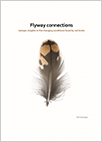PhD defence Tim Oortwijn
| When: | Tu 09-09-2025 at 11:00 |
| Where: | Academy Building & online |

Flyway connections
Isotopic insights in the changing conditions faced by red knots
Climate change affects life on Earth in many ways. This thesis contributes to understanding these effects through the analysis of stable isotopes, which provide insights into the ecology of red knots. Experiments with captive birds showed how isotopes from food are incorporated into tissues, enabling reconstructions of diets and timing of migration. This allowed the development of a model to estimate arrival and stopover duration in the Wadden Sea for red knots migrating from West Africa to Siberia. It was also demonstrated how the chemical composition of the most common bivalve species in Mauritania influences red knot intake rates. Due to the presence of sulphur in this species, consumption rates are limited, and potentially also limit the rate at which they can fuel up in spring for the long flights towards the breeding grounds. On the tundra we showed how a new technology, thermal imaging, supports research by detecting well-camouflaged nests and chicks of red knots. We also discuss how increasing rainfall in the breeding areas, as part of climate change, may affect chick survival. Besides this, we demonstrated that red knots face a trophic mismatch, by analysing stable isotopes in the feathers of young birds caught in Mauritania. These feathers, grown as chicks on the tundra, reveal that the contribution of crane flies to chick diets has declined over nearly two decades. At the same time, snowmelt advanced, but red knots did not breed earlier, resulting in smaller body sizes among young birds.
